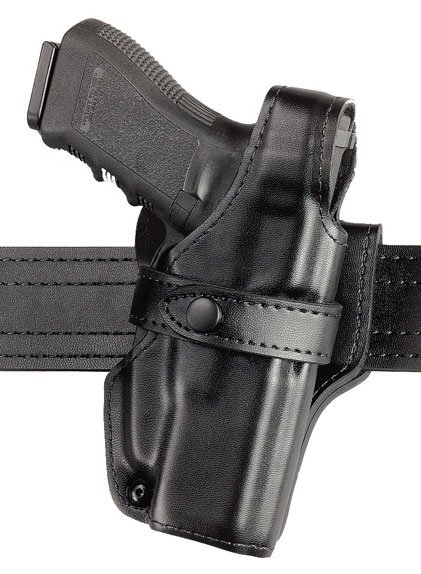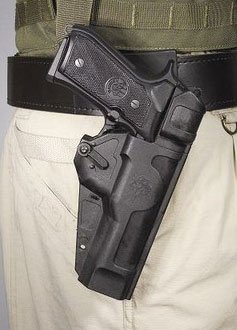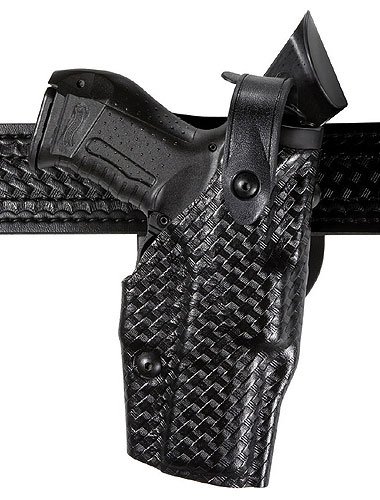The retention-style duty holsters fielded today represent a quantum leap over earlier designs in that the handgun can be drawn very quickly by the practiced user, but make unauthorized removal extremely difficult.
There is no such thing as a “snatchproof” holster. Given enough time and opportunity, any holster can be defeated. However, the holster manufacturers have come up with a number of snatch-resistant designs and, today, most uniformed officers are wearing some type of retention holster. Combined with officer awareness, training in retention techniques, and a backup plan, a quality holster represents another layer of defense.

Safariland SSII 070 duty holster
More than 30 years ago, my agency purchased a quantity of Security-Plus holsters from Smith & Wesson®’s now defunct leather company. The Security-Plus required a specific motion on the draw stroke to clear leather and, while primitive by contemporary standards, it did work. Shortly after these holsters were put into service, one of our officers was brutally attacked by multiple assailants who attempted to remove his revolver. That disarm attempt failed, largely because of the holster design. Three decades later, we really don’t know how many “saves” can be attributed to retention holsters, but that number is probably in the hundreds.
Safariland, a major manufacturer of police duty holsters, popularized the concept of different levels of retention. In short, a Level I holster has a single retention device such as a thumb break. If we up the ante to Level II, two devices, or motions, are required to draw the gun. Obviously, on a Level III holster, the user has to perform three steps to get the handgun into action. An example of a Level III holster is the Bill Rogers designed Safariland 070 which requires the user to manipulate a thumb break, middle finger release, and perform a specific motion in order to free the gun.
What Works Best?
So, what is the optimum level of retention? That is the $64 question and any number of factors comes into play. Obviously, adding more steps on the draw stroke can complicate the picture. This is a much easier issue to address for the individual officer versus an entire agency. Exactly how much time can we devote to training and can we really expect less committed officers to practice on their own?
Let’s check out a number of popular designs to see what they have to offer. Like many things in life, selection of the duty holster is often a com- promise and we may have to balance security and officer efficiency. This is especially true in equipping large numbers of officers with various aptitudes and levels of commitment.
BLACKHAWK! SERPA
In less than ten years, BLACKHAWK! has risen from a nonentity to a major player in the duty holster sweepstakes. Their proprietary SERPA technology has been adapted to concealment, tactical, and light bearing designs, as well as duty holsters. BLACKHAWK! duty holsters are available in both Level II and Level III configurations and are available for a wide range of popular handguns.
I was introduced to the SERPA Level II Duty Holster several years ago and, to date, my experience has been very positive. Security is achieved by a passive retention adjustment screw and the SERPA Auto LockTM release. To draw from this Level II holster, the user places the pad of the index finger on the top of the SERPA release. By applying pressure with the extended finger, the lock is instantly released and gun can be lifted out. This draw stroke is very intuitive and is easily mastered with minimum practice. Upon return, the pistol is automatically locked in and remains secure until the SERPA release is depressed.
For added security, consider the SERPA Level III Duty Holster. In addition to the passive reten- tion and SERPA lock, the Level III features a thumb activated pivot guard for additional security. Both the SERPA lock and pivot guard must be released in order to draw the handgun. The good news is that both devices can be unlocked in a single motion, making for very fast draw times. Additionally, I discovered that an emergency draw stoke with the support hand is more easily accomplished than with other Level III holsters.
SERPA Duty Holsters are crafted from carbon fiber and can be had in plain, matte, or basket weave finishes. Mid ride and high ride belt loops are available to suit an officer’s preference. Another positive feature with SERPA holsters is that it is very easy to obtain an optimum shooting grip on the holstered handgun as soon as the hand makes contact. All of these qualities clearly put the BLACKHAWK! SERPA in the winner’s circle. These attributes have not been lost on the Chattanooga, TN, Police Department and they have selected the BLACKHAWK! Level III SERPA hol- ster for use by all uniformed patrol officers.
DeSantis Stryker
We normally associate DeSantis Gunhide with quality concealment holsters; however, this New York based firm also turns out some innovative duty rigs as well. Their most recent offering represents their best effort yet.
 The DeSantis Stryker is constructed of a supertough polymer which should provide years of reliable service and a longer service life than any leather duty holster. Depending on user preference, the Stryker can be set for Level II or Level III security. To draw from the Stryker, the user depresses a spring-loaded paddle with the shooting hand thumb. The thumb naturally falls to the paddle as the user obtains a shooting grip. By using the paddle release alone, the Stryker affords Level II security.
The DeSantis Stryker is constructed of a supertough polymer which should provide years of reliable service and a longer service life than any leather duty holster. Depending on user preference, the Stryker can be set for Level II or Level III security. To draw from the Stryker, the user depresses a spring-loaded paddle with the shooting hand thumb. The thumb naturally falls to the paddle as the user obtains a shooting grip. By using the paddle release alone, the Stryker affords Level II security.
The Stryker also features a small lever on the outboard side of the holster, even with the bottom of the holstered pistol’s trigger guard. With the lever in the three o’clock position, the paddle cannot be released. Sweeping the lever down will unlock the paddle, enabling the user to draw the pistol.
Both of these devices can be released in one fluid motion by the practiced user. With the lever up, the Stryker offers Level III security.
Hangers for high ride, mid ride, or tactical thigh carry are sold separately. A MOLLE mount for affixing the Stryker to a vest is also available. The angle of carry can be adjusted in six degree increments to suit the user’s preference.
I utilized the Stryker with a Beretta 92D pistol and draw times were pretty snappy, even with the Level III security option activated. If you prefer Level II security, always run the trigger finger down alongside the holster in the event the safety lever has been inadvertently flipped up. I also liked the fact that the pistol is automatically secured upon return, without the need for additional movements.
Gould & Goodrich K340
Gould & Goodrich is yet another big player in the law enforcement market and their holsters are in use by a number of large agencies, including the Maine State Police, the Pennsylvania State Police, the St. Louis Police Department, and the Hong Kong Police Department. In recent years, G&G has upgraded their line of security holsters and they currently offer a number of well thought-out designs. I recently obtained a K340 Double Retention duty holster for review which combines classic styling with superior retention qualities.
The K340 is constructed of a waterproof polymer laminate with a DuroPro rigid middle. This K-Force holster is both weatherproof and scuff-resistant and, to the casual eye, looks very much like leather.
To draw from the K340, the user disengages the thumb break and gives the gun a slight twist to the inside. The pistol can be removed from the holster and brought to bear on target. Upon return, the pistol is automatically secured, even if the thumb break is not fastened.
I found that the keys to success with the K340 was a tight belt and placing belt keepers both fore and aft of the holster. Set up in this manner, the draw stroke is very fast. Drawing with the support hand to simulate an injury is also very straightforward.
In addition to the K340, G&G also produces the T340, an identical holster crafted of nylon. Other K-Force options include the Double Re- tention Quantum K381 and Triple Retention Quantum K391.
Safariland ALS
It would not be too far off the mark to suggest that Safariland wrote the book on retention holsters. In 1985, Safariland purchased the Rogers Holster Company, a trendsetter in security designs. Rogers developed the security rating system which is used throughout the industry to this day. The original Rogers designs, including the SS2 and SS3, morphed into the Safariland 295 and 070 which are still in production. In fact, the Safariland 295 remains the standard duty holster of the New York City Police Department.
In the 1990s, Safariland introduced the innovative SLS (Self Locking System) line of security holsters. Instead of a traditional thumb break to secure the holstered pistol, SLS holsters used a rotating hood. The hood is a much more formidable obstacle to a gun grab than a snap. Should the officer have to reholster quickly and resort to a lower force option, sweeping the hood up is far easier than affixing a snap. The Safariland SLS 6280 is indeed a very good rig, but Safariland was not content to rest on its laurels.

For the last several years, my agency has utilized the Safariland 6360 which is best described as the next evolution in the firm’s line of retention holsters. The 6360 is a member of the ALS (Automatic Locking System) family and boasts any number of advantages over the groundbreaking 6280. As soon as the gun is returned to the holster, it is automatically locked by the ALS system. If the officer is involved in a violent struggle, the gun remains secure, even if the rotating hood is down.
The ALS line of holsters secures the pistol by the ejection port. To unlock the holster, the user rotates the hood down and depresses the operating lever. The shooting hand thumb naturally falls to the lever once the hood is in the down position and this two step process is virtually effortless. Once the lever is brought back to the rear, the pistol can be lifted from the holster.
Another added security feature of the ALS line is the Hood Guard which prevents anybody, or anything, from compromising the Auto Locking System. For users who desire an even greater margin of security, Safariland offers the optional Sentry, affording Level IV retention.
ALS holsters are available in a variety of finishes, including Plain Black, Basket Weave, Hi-Gloss, or STX Tactical with a SAFARILAMINATE finish to mirror the look of leather. Light bearing models are also available to accommodate pistols with tactical illuminators.
When All Else Fails
Unlike a compliant partner in a defensive tactics class, real-world confrontations don’t follow a script and can get ugly very fast. I doubt if any of the drills you performed in your last weapon retention class began with your partner smashing you in the head with a bottle or pushing you down a flight of stairs. That is the real world and, suddenly, all of those nifty retention techniques we learned in the gym go right out the window.
I’m not suggesting we shouldn’t practice proven retention techniques; in fact, we need to work more intensely in all facets of close quarters fighting. You may, however, want to consider a backup plan for those worst-case scenarios when you’ve sustained a serious injury or are under attack by multiple assailants hell-bent on boosting your gun.
If regulations permit, and with the proper training, I strongly suggest you consider taking up a backup gun and/or a knife. When in uniform, I made it a practice to carry a hidden second gun. Ideally, your backup gun should be accessible to either hand and one of the better carry modes is the BUG Pocket marketed by R&Y Custom Vest Carriers. Designed by retired LAPD Sergeant Randy Garcia, the BUG Pocket is essentially a holster which places your backup on the carrier of your soft body armor. With today’s small, yet powerful, handguns, there is simply no excuse for not carrying a backup.
A knife can also be a force multiplier in a dire situation. I daresay most cops carry a folding knife for utility work, but really haven’t given serious thought to using it in an emergency. Opening a conventional folder when trying to maintain control of your holstered pistol is extremely difficult. My solution is the Spyderco P’Kal. This blade features the Emerson opening feature which hooks on the pocket’s edge on the draw. The locked blade can quickly be brought into action in stopping the attack.
And the Winner Is…
In a recent class, a student asked me to identify the “best” retention holster in today’s market. The fact of the matter is that there is no absolute answer. Frequency of training, the type of firearm used, and an honest appraisal of the talent pool all weigh into the equation. Minimally, I would suggest a Level II holster for uniformed patrol. Level III is better yet, but only when combined with regular training. Training in both holster skills and weapon retention remains an integral part of my agency’s in-service training. The autolocking features of the holsters reviewed herein make them a better choice than earlier models which required an additional step to secure the gun.
Retention holsters remain an important component of officer safety. When selecting a holster for duty use, agencies and individual officers should use the same care as select- ing a handgun. Choose wisely and make weapon retention a regular part of your in- service training program. A prepared officer with quality gear is a formidable obstacle to an assailant who would do him, or others, harm.
About the Author: Captain Mike Boyle served with New Jersey Division of Fish & Wildlife, Bu- reau of Law Enforcement, and has been an active firearms instructor for more than 30 years. He has been an assistant police academy director and remains active as an academy rangemaster and instructor. Mike has served on the Board of Directors of the International Association of Law Enforcement Firearms Instructors (IALEFI) since 1996. He is the architect and coordinator of IALEFI’s Master Instructor Development Program.
This article is a contribution from articles and gear reviews for the patrol officer. P&SN is a valued supporter of BlueSheepdog and the Blue Crew. You can obtain a free subscription to the Police & Security News magazine by joining the Blue Crew.